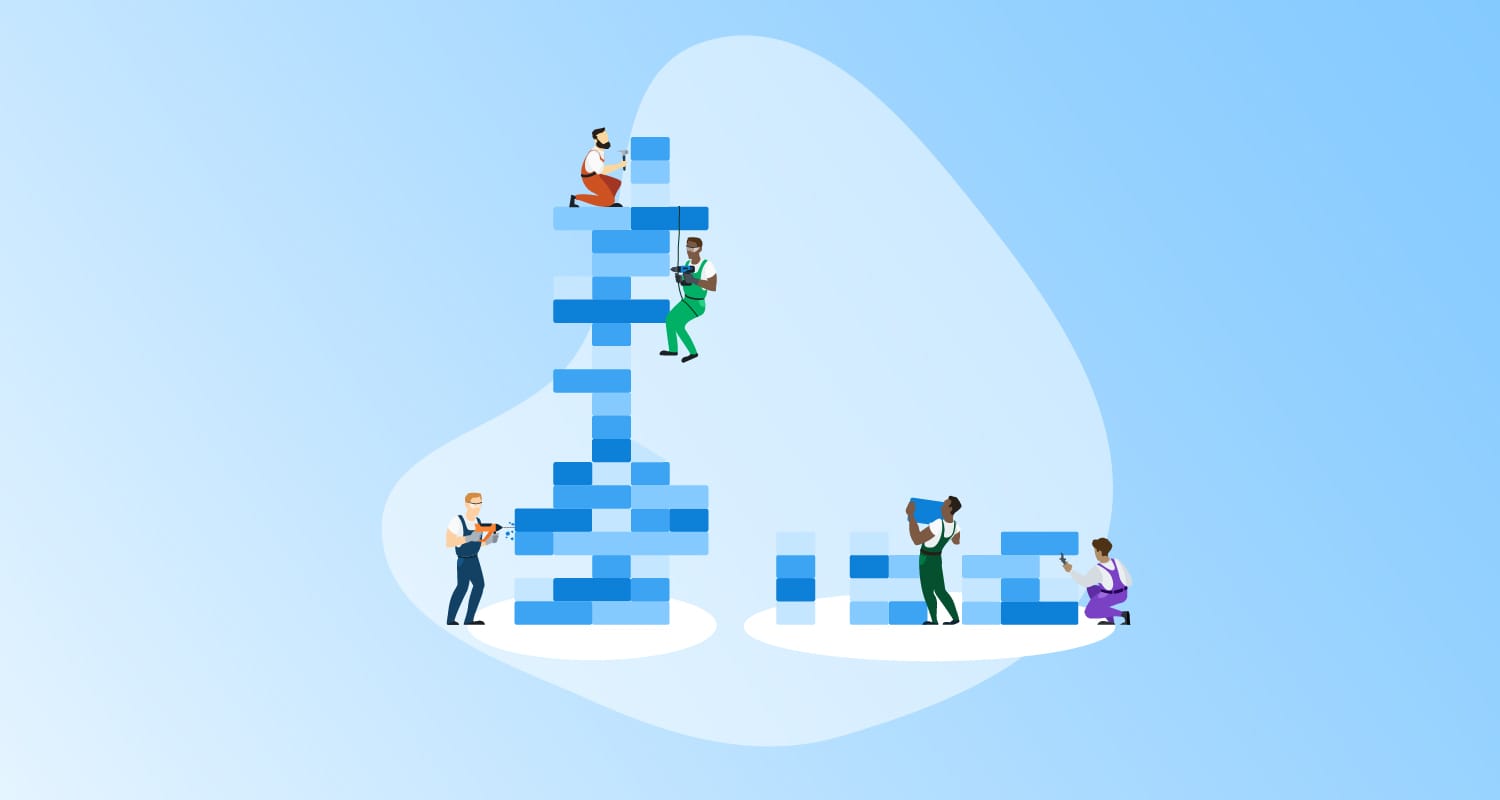What is a DevOps pipeline?
A DevOps pipeline is an automated system that integrates various practices and tools to enhance efficiency and reliability in the software development process. It covers the entire software delivery cycle, from code development to application deployment, often called Continuous Integration/Continuous Delivery (CI/CD). A DevOps pipeline ensures that software is delivered faster and with higher quality by automating tasks and increasing development and operations collaboration.
Typically, a DevOps pipeline includes stages like code build, testing, integration, deployment, and monitoring. It includes tools that automate these processes, ensuring consistent and repeatable workflows. The primary goal is to create a predictable path from code development to deployment, emphasizing automation to reduce human intervention and error.
While many are touting the death of DevOps, as of 2025 it is alive, kicking, and rapidly growing. The DevOps market is currently worth $13 billion and estimated to grow to $81 billion by 2033. However, DevOps is evolving, with a greater focus on platform engineering. According to Google’s latest DORA report, 89% of organizations now use an internal developer platform. Below we’ll explain more about the impact of platform engineering on DevOps pipelines.
TL;DR: 6 Steps to build your DevOps pipeline
Before we get into all the details about DevOps pipeline components, stages, etc. Here are the quick steps you can take to build your own DevOps pipeline today.
1. Set up a build server
Your build server will automate the compilation of code into executable applications or packages and the execution of automated tests. You may have build capabilities within your version control tools, like GitHub or GitLab, or you can use a separate build tool like Jenkins, Travis CI, or CircleCI.
When you commit a change to version control, your build server should respond by triggering the automated build pipeline and, if successful, uploading the output to an artifact repository.
2. Create a CI process for rapid feedback
Once you have a build server, you can design your Continuous Integration (CI) process. Your aim should be to compile the application and run fast automated tests to validate it. A developer should know within 5 minutes if there’s a problem with their change, so they can rapidly bring the software back into a deployable state.
Longer-running tests should happen in a separate stage to ensure the initial build gives developers fast feedback. These tests only need to run after the build and its initial tests are successful.
After all validation stages pass, the artifact can be uploaded. You should use the same artifact to deploy to all environments.
3. Set up a deployment automation system
Deployment automation speeds up the process but also makes it more reliable. A deployment tool won’t forget a step or perform steps out of order, so you can make sure all deployments happen the same way every time. Use deployment tools like Octopus to manage your deployments and handle application configuration.
You should use the same automated process to deploy to all environments, as this tests the deployment process as often as the software version. Making sure a software version progresses with the same version of the deployment process (and the same artifact) ensures you don’t introduce an unintentional variation.
4. Create a CD process to manage environment progression
Continuous Delivery (CD) involves progressing a software version through environments to increase confidence that it’s a good version. Early environments validate functionality or security, but a more production-like environment may be needed to test the fitness of other aspects of the software, like performance or its operation when traffic passes through a load balancer.
Deployment automation tools like Octopus can handle environment progressions and provide the appropriate application configuration for each environment.
5. Set up automated testing tools
Automated testing tools are critical in maintaining code quality and catching issues early. Each programming language has an associated set of unit, integration, and user-interface testing tools, such as JUnit and Selenium for Java, or Jest and Playwright for TypeScript.
These tests will be executed within your CI process, so you should optimize the initial tests to provide feedback in 5 minutes, and defer long-running tests. When a bug escapes, you should add a new test to catch it in the future. Try to catch as many problems as early as possible, while maintaining the goal of 5 minute feedback.
6. Set up monitoring and observability for the production environment
Monitoring allows you to understand how the software performs when subjected to the unpredictable load and uses of the real world. Use tools like Prometheus, Grafana, or Datadog to collect data, create automated alarms, and see inside the system when things go wrong.
Correlating metrics and events from your system within your monitoring tools should help you understand the causes of any unexpected faults or outages. You can improve your software’s observability by improving the metrics and event information you provide to the monitoring tools.
What are the benefits of a DevOps pipeline?
Faster software delivery
The DevOps pipeline takes over when a developer commits code and uses automation to smooth the path to production. For this to work, everything is arranged to be a continuous process, and repetitive tasks are handled by tools and scripts, reducing the need for manual intervention and reducing downtime and outages. By allowing for rapid delivery of new software versions, teams can test feature ideas, validate their direction, and improve their software.
Improved reliability and quality
DevOps pipelines use continuous testing practices, which directly impact software quality. Automated tests run each time the code changes, catching defects and issues early in the development cycle. This means a software version has its fitness validated before progressing to later stages. This proactive approach ensures that software meets high standards of reliability and performance.
The collaborative nature of a DevOps pipeline facilitates better communication between development, QA, and operations teams. This integrated approach allows for real-time feedback, ensuring that anomalies are addressed swiftly and encouraging shared responsibility for software quality.
Shorter feedback cycles
When you increase your deployment frequency, each software version has fewer changes. That makes identifying the cause of a problem easier and eliminates complex merge operations. Developers should get feedback from automated tests within 5 minutes, with longer-running tests providing feedback when they are complete. Each validation stage is a chance to prevent wasting time on a bad software version, as only good versions progress.
Key components of a DevOps pipeline
Continuous Integration and Continuous Delivery (CI/CD)
Continuous Integration (CI) involves merging code changes into the main branch multiple times a day. Each change triggers automated builds and tests. This practice quickly identifies defects and highlights errors before they snowball into more significant issues. By integrating often, developers avoid the pitfalls of large merge conflicts and make sure the codebase remains healthy and deployable at all times.
Continuous Delivery (CD) extends CI by automating the delivery of applications to a production-like environment. When a software version passes the validation steps, it should be deployable at the push of a button. In some cases, the progression through environments may be automatic. CD ensures that software can be reliably released anytime, reducing the risk associated with releases and maintaining software quality.
Continuous Deployment
Continuous Deployment goes beyond Continuous Delivery. Every change that passes the automated tests is automatically deployed to production. This improves deployment frequency and reduces the manual effort involved in releasing updates. With Continuous Deployment, teams can focus on code quality and business goals rather than managing deployment.
While Continuous Delivery requires that the software be deployable at all times, Continuous Deployment proves this by automating all steps and placing good software versions into production without manual intervention. This is as much a cultural change as a technical one as developers will be aware that changes will automatically progress all the way to real users.
Continuous testing
Continuous testing integrates automated testing into every step of the DevOps pipeline. This strategy ensures software quality at each transition from development to operations. This ongoing testing strategy quickly identifies defects, reducing the risk of downstream issues. Automated tests are triggered at every build, ensuring new code does not introduce bugs.
To be most effective, the testing strategy should go beyond the software’s behavior and consider concerns such as security and performance. This provides high-quality feedback to developers each time they commit a change, letting them quickly resolve any issues they introduce and keep the software high quality.
Continuous monitoring
Continuous monitoring means keeping watch over the system’s performance to ensure reliability and stability. Monitoring tools collect data in real-time, providing insights into application performance, server health, and network traffic. These metrics enable teams to proactively address potential issues, maintaining optimal system conditions.
Any changes that could degrade service are quickly identified and rectified through alerts and alarms within continuous monitoring tools. This minimizes downtime and outages for users and ensures a new software version doesn’t negatively impact business metrics.
Continuous feedback
Continuous feedback provides actionable insights into application performance and user experience, directly influencing future development cycles. By integrating feedback loops within the pipeline, teams receive immediate input from users, stakeholders, and internal metrics. This fosters a development approach that responds to user needs and aligns with business goals.
These feedback mechanisms also support continuous improvement, helping to identify areas for enhancement and optimization. Through ongoing feedback, development teams can prioritize features and fixes that deliver the most value to users.
Continuous operations
Continuous operations is a set of practices for managing infrastructure to meet service-level objectives and handle business continuity. It includes the systems and processes needed to prevent and handle faults across a range of severities.
Strategies for continuous operations include redundancy, automated failover, and distributed architectures. These solutions are resilient to hardware failures and ensure applications remain accessible during maintenance windows or unpredictable events.
The evolution of DevOps pipelines: How does the platform engineering trend impact DevOps?
Platform engineering is reshaping how organizations design, manage, and evolve their DevOps pipelines. By introducing internal developer platforms, platform engineering abstracts away repetitive tasks and standardizes environments, allowing developers to focus on writing code rather than managing infrastructure.
Here are the key ways platform engineering influences DevOps pipelines:
- Standardization of environments: Platform engineering provides self-service infrastructure as a product, making it easier to define and enforce consistent configurations across development, testing, and production. This consistency reduces environment drift and deployment failures.
- Improved developer experience: IDPs offer tools, services, and workflows that simplify the deployment and operation of applications. Developers can access pre-approved templates, automated CI/CD workflows, and integrated monitoring, all without deep expertise in infrastructure management.
- Faster onboarding and scaling: New developers can start contributing quickly by using platform-provided pipelines and deployment patterns. This reduces the time spent learning environment-specific details and accelerates team productivity.
- Enhanced security and compliance: Platform engineering embeds security and compliance controls into the pipeline itself. With built-in security scanning, role-based access controls, and audit trails, teams can meet regulatory requirements and reduce risks.
- Integration with cloud-native technologies: Modern IDPs often integrate container orchestration (like Kubernetes), service meshes, and observability stacks. This simplifies the adoption of cloud-native patterns within DevOps pipelines, making them more scalable and resilient.
- Shift-left practices: Platform engineering supports shift-left approaches by embedding testing, security, and compliance earlier in the pipeline. This aligns with DevOps goals of faster feedback and higher quality releases.
By implementing platform engineering alongside DevOps, organizations can build pipelines that are more consistent, secure, and developer-friendly, while retaining the agility and automation that DevOps promises. This combination accelerates software delivery and improves overall system reliability.
8 Stages of the DevOps pipeline
Let’s review the primary stages of a modern DevOps pipeline.
1. Plan
Planning establishes the scope and direction of development work. This phase involves gathering requirements from stakeholders, defining user stories, estimating effort, and setting sprint or release goals. Teams use Agile methodologies such as Scrum or Kanban to manage workflows, often relying on tools like Jira, Trello, or Azure Boards. Planning includes breaking down features into manageable tasks, assigning responsibilities, and aligning technical priorities with business needs. Clear documentation and shared understanding are critical to prevent scope creep and ensure consistent progress toward objectives.
2. Code
In the coding stage, developers write, refactor, and review source code. They work within version control systems like Git, using branches to isolate features, bug fixes, or experiments. Best practices include writing modular, readable code, adhering to coding standards, and documenting logic where necessary. Peer code reviews catch potential issues early and promote knowledge sharing. Teams often implement pre-commit hooks and static analysis tools to enforce consistency and detect basic bugs before the code progresses further. Continuous integration systems typically trigger upon commits, reinforcing rapid feedback.
3. Build
The build phase compiles the source code into binaries or other deployable formats. This includes resolving dependencies, running scripts, and generating artifacts. Common tools include Jenkins, GitLab CI, CircleCI, and Azure Pipelines. Builds should be deterministic—given the same inputs, they produce the same outputs. This phase may also include steps like code signing, creating Docker images, or packaging files for distribution. Build automation ensures consistency across environments and catches errors like missing dependencies or syntax problems early in the cycle.
4. Test
Testing ensures the software meets quality and reliability standards. It includes multiple layers:
- Unit tests check individual components.
- Integration tests verify interactions between services or modules.
- End-to-end tests simulate real user scenarios.
Other tests include performance benchmarking, security scanning (SAST/DAST), and accessibility checks. Automated tests run with each build, and failures prevent promotion to later stages. A robust test suite offers fast, actionable feedback to developers. Continuous testing reduces manual QA workload and increases the confidence that changes won’t introduce regressions.
5. Release
Release management coordinates the movement of a software version from staging to production. This step involves tagging versions, updating release notes, and validating that the software meets compliance and business readiness criteria. Approvals from QA, security, or product teams may be required. Feature flags and release toggles allow partial rollouts or disabling problematic features without redeploying. This stage focuses on minimizing risk and ensuring traceability of what is released and when. Automated release pipelines handle these transitions consistently.
6. Deploy
Deployment automates the installation of software into its target environment. Strategies include:
- Blue/green deployments for zero-downtime switches
- Canary releases to test changes with a subset of users
- Rolling deployments to gradually replace instances
Deployment automation uses scripts or infrastructure as code tools like Ansible, Helm, or Terraform. A good deployment process supports rollback mechanisms and deployment verification steps. Logs, health checks, and smoke tests validate the success of each deployment. Teams aim for deployments that are frequent, fast, and uneventful.
7. Operate
Operations maintain the stability and performance of applications in production. Tasks include resource provisioning, patching, scaling, and handling runtime configuration. Infrastructure should be automated and versioned, enabling reproducible environments. Monitoring and alerting systems identify issues like increased latency or failed services. Runbooks and incident response playbooks help standardize reactions to common problems. The operations phase often overlaps with site reliability engineering (SRE) practices focused on reducing toil and ensuring high availability.
8. Monitor
Monitoring continuously tracks the health, performance, and usage of the application and infrastructure. It covers metrics like response time, error rates, throughput, CPU/memory usage, and custom business metrics. Tools like Prometheus, Grafana, ELK Stack, and Datadog visualize and alert on anomalies. Logs and distributed tracing help diagnose problems and analyze system behavior during incidents. Monitoring is critical not just for detecting failures, but also for optimizing performance, understanding user behavior, and feeding insights back into planning and development.
CI/CD with Octopus
Octopus is a leading Continuous Delivery tool designed to manage complex deployments at scale. It lets software teams streamline Continuous Delivery and accelerate value delivery. With over 4,000 organizations worldwide relying on our solutions for Continuous Delivery, GitOps, and release orchestration, Octopus ensures smooth software delivery across multi-cloud, Kubernetes, data centers, and hybrid environments, whether dealing with containerized applications or legacy systems.
We empower Platform Engineering teams to enhance Developer Experience (DevEx) while meeting governance, risk, and compliance (GRC) needs. Additionally, we are dedicated to supporting the developer community through contributions to open-source projects like Argo within the CNCF and other initiatives to advance software delivery and operations.
Get started with Octopus
Make complex deployments simple
Help us continuously improve
Please let us know if you have any feedback about this page.



